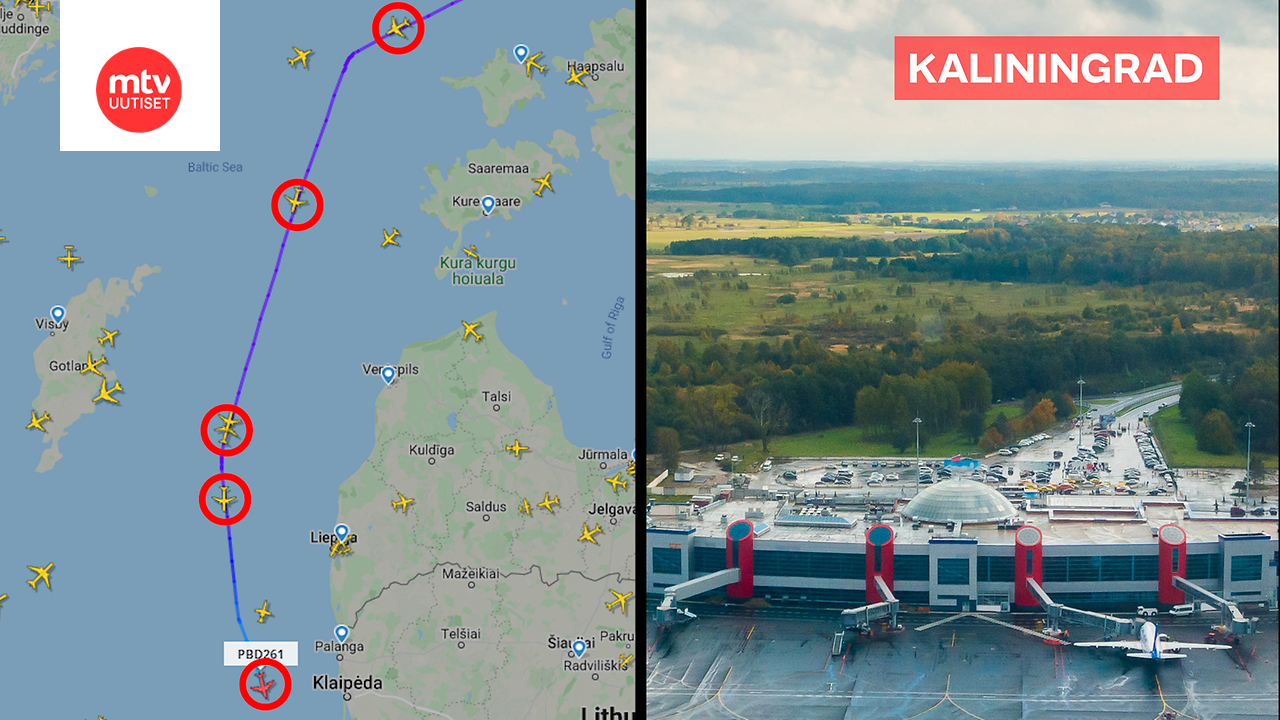Kyllä se niin taitaa olla, että jos Putin päättää, että nyt ammutaan nukeja, niin sitten ammutaan. Mitäs sille kukaan mitään mahtaisi kun ei ole mahtanut tähänkään asti.Niin luulisi, mutta on tässä monet luulot menneet pieleen jo tätä ennenkin, kuka uskoi oikeasti ryssän täysimittaiseen maahyökkäykseen Ukrainaan. Minä tunnustan että itse en ainakaan uskonut, ennenkuin korkeintaan 1-2 viikkoa ennen hyökkäyksen alkamista, mutta epäuskoinen olo oli vielä silloinkin että mitä vittua Venäjä??? Ja täytyy muistaa että vaikka Putin olikin hyökkäyksen takana niin ei se sinne Ukrainaan yksin hyökännyt. Ihan sama noiden hiton ydinaseiden kanssa, että vaikka se Putin ei niiden käytöstä yksin päätä niin kovin moneen hullutukseen se on jo tätä ennenkin saanut maanmiehensä mukaan.
Install the app
How to install the app on iOS
Follow along with the video below to see how to install our site as a web app on your home screen.
Note: This feature may not be available in some browsers.
You are using an out of date browser. It may not display this or other websites correctly.
You should upgrade or use an alternative browser.
You should upgrade or use an alternative browser.
Ukrainan konflikti/sota
vompatti
Kenraali
Slovakiasta ilmeisesti on tulossa S-300:sia nopealla aikataululla
Vähän vakavammin koitan kirjoittaa: Olen tässä pohtinut, että saavuttaakseen merkittäviä voittoja on Venäjän saatava V-V mukaan toimintaan, jotta se sitoisi suuren määrän Ukrainan joukkoja tai sitten Venäjän on suoritettava LKP kohtuullisen suurilla alueilla. Jos joutuvat LKP vaihtoehtoon, niin aikajänne tulee olemaan pitkä ennen kuin saavat tarvittavat vahvistukset Ukrainaan. Jos V-V ei lähde pikaisesti mukaan, niin aloite tulee siirtymään osittain Ukrainalle ja se voi olla Venäläiselle todella huono tilanne. Vaikka Venäjä aloittaisi LKP:n, niin ne joukot eivät lähiviikkoina todellakaan ehdi apuun ja Ukraina ehtii ottamaan sitä aloitetta käsiinsä.
Venäjä voisi muuttaa tilannetta uhkaamalla ydinaseella tai jopa käyttää sellaisen, mutta silloin Venäjä on pelannut kaikki korttinsa ja maailmassa ei ole jäljellä kuin vihollisia heille. Epäilen, että ydinaseella voidaan jopa uhkailla, mutta todellisuudessa sillä vaan suojataan se ettei kukaan kohdista sotilaallista toimintaa Venäjän omalle maaperälle. Venäjä ei tule käyttämään ydinasetta Ukrainassa.
Venäjällä on nyt huonot kortit ja uskokaa tai älkää, niin tulitauko ja sitten aselepo kohti rauhaa tulee pian. Ei Venäjä täysin kädetön ole ja pelaa taustapeliä takuulla ja tilanne menee siihen, että Ukraina tullaan osaltaan pakottamaan rauhaan länsimaiden toimesta (Ukraina todellakin tietää, että sen kyky puolustautua on riippuvainen länsimaiden tarjoamasta avusta, jota se on saanut hyvin hyvin avokätisesti).
Jos Putin pysyy vallassa, niin seuraava häirinnän kohde voi olla Viro ja se järjestetään niin että itä-Viron Venäläinen väestö aloittaa levottomuuksia ja Venäjä vain levittelee käsiään aluksi ja on erittäin huolestunut Venäläisen kansanosan kohtelusta...
Muu maailma punnitaan sitten, että kuinka pitkään pakotteet pidetään voimassa? Yleensä rahasta johtuvista syistä, sattuu kummasti kaikenlaisia lipeämisiä.
Suomi saa kiittää Ukrainaa ettei Venäjä voittanut viikossa, koska se olisi huonontanut asemaamme merkittävästi. Nyt voi vaan kiittää niitä tahoja, jotka ovat pitäneet itsenäisen Suomen puolustuskyvyn riittävän vahvana!
Venäjä voisi muuttaa tilannetta uhkaamalla ydinaseella tai jopa käyttää sellaisen, mutta silloin Venäjä on pelannut kaikki korttinsa ja maailmassa ei ole jäljellä kuin vihollisia heille. Epäilen, että ydinaseella voidaan jopa uhkailla, mutta todellisuudessa sillä vaan suojataan se ettei kukaan kohdista sotilaallista toimintaa Venäjän omalle maaperälle. Venäjä ei tule käyttämään ydinasetta Ukrainassa.
Venäjällä on nyt huonot kortit ja uskokaa tai älkää, niin tulitauko ja sitten aselepo kohti rauhaa tulee pian. Ei Venäjä täysin kädetön ole ja pelaa taustapeliä takuulla ja tilanne menee siihen, että Ukraina tullaan osaltaan pakottamaan rauhaan länsimaiden toimesta (Ukraina todellakin tietää, että sen kyky puolustautua on riippuvainen länsimaiden tarjoamasta avusta, jota se on saanut hyvin hyvin avokätisesti).
Jos Putin pysyy vallassa, niin seuraava häirinnän kohde voi olla Viro ja se järjestetään niin että itä-Viron Venäläinen väestö aloittaa levottomuuksia ja Venäjä vain levittelee käsiään aluksi ja on erittäin huolestunut Venäläisen kansanosan kohtelusta...
Muu maailma punnitaan sitten, että kuinka pitkään pakotteet pidetään voimassa? Yleensä rahasta johtuvista syistä, sattuu kummasti kaikenlaisia lipeämisiä.
Suomi saa kiittää Ukrainaa ettei Venäjä voittanut viikossa, koska se olisi huonontanut asemaamme merkittävästi. Nyt voi vaan kiittää niitä tahoja, jotka ovat pitäneet itsenäisen Suomen puolustuskyvyn riittävän vahvana!
Tuleehan tänne Allegroilla kokoajan näitä samoja venäläisiä.
Lisäksi VR pyrkii saamaan nopeasti luvat tuoda tänne myös kolmansien maiden tulijoita. Siis niitä jotka eivät ole EU kansalaisiakaan.
Syyrialaisia esimerkiksi ?
Tulihan tänne aikanaa myös diktaattori Siad Barren luottomiehiä moskovasta. . . .
Vähän erikoinen fiilis, kun on kai jo toinen Kansan uutisten artikkeli, jonka linkitän tänne (ja perään muutama muu kiinnostava tältä päivältä, ja samoihin aiheesiin liittyviä hieman vanhempia lopuksi):

Ukrainan tiedustelupalvelu: Syyria luvannut 40000 sotilasta Venäjän apuun – osa aikoo loikata EU-alueelle
Värvättäville ei kerrottu taistelutehtävistä vaan järjestyksen pitämisestä. Syyrian presidentti Bashar al-Assad on luvannut Venäjän avuksi 40 000 sotilasta sen Ukrainassa käymään

”Tilanne on paha” – Vladimir Putinin sanotaan tiedostavan ongelmat | Verkkouutiset
”Tilanne on paha” – Vladimir Putinin sanotaan tiedostavan ongelmat | Verkkouutiset
 www.verkkouutiset.fi
www.verkkouutiset.fi

Näin Venäjä testaa, mikä propaganda toimii ja mikä ei, sitten vuoroon astuvat trollit ja some – suomalaisasiantuntija: Sodan molempien puolien tietoja kannattaa epäillä
Venäjän harjoittama propaganda ei tutkijan mukaan pure länsirintamaan. Suomessa esimerkiksi laadukas mediakasvatus suojaa kansalaisia vaikuttamisyrityksiltä.

Suomen suosituin salaliittoteoria on vuosikymmeniä vanha – aihetta tutkinut toimittajakin uskoo siihen jonkin verran: ”Minulle ei käy järkeen”
Tuore kirja Salaliittoteorioiden ihmemaassa etsii vastausta siihen, miksi tavallinen ihminen on valmis rikkomaan jopa perhesuhteensa outojen uskomusten vuoksi.

Suomenlahdella lentää vilkas venäläiskoneiden letka – mukana kaksi armeijan konetta, joiden alkupiste ja määränpää salainen
Suomenlahdella liikennöi tällä hetkellä paljon venäläiskoneita. Samaan aikaan, kun Venäjä sotii Ukrainan kanssa Itä-Euroopassa, on Suomenlahden läpi kulkeva lentoreitti Moskovasta ja Pietarista Kaliningradin alueelle muuttunut viime päivinä vilkkaaksi.

Ukrainan sota | ”Rituaali, jolla ei ole nyt mitään käytännön merkitystä”, arvioi venäläisprofessori Venäjän ja Ukrainan rauhanneuvotteluja
Neuvotteluissa on vaikeaa edetä taistelujen jatkuessa voimakkaina, sanoo Pietarin Eurooppalaisen yliopiston professori Grigori Golosov.

”Jos Putin olisi ehdolla Serbiassa, hän saisi yli 70 prosenttia äänistä” – Belgradissa on kannettu Putinin kuvia ja liehuteltu Venäjän lippuja
Serbian ainoa vaihtoehto on kääntyä länteen, arvioi turvallisuusasiantuntija. Käännös voi tapahtua jo huhtikuun alun vaalien jälkeen.

Venäjän joukot ryöstelevät ja ampuvat siviilejä | Verkkouutiset
Venäjän joukot ryöstelevät ja ampuvat siviilejä | Verkkouutiset
 www.verkkouutiset.fi
www.verkkouutiset.fi

"Äiti, me tapamme siviilejä täällä" | Verkkouutiset
"Äiti, me tapamme siviilejä täällä" | Verkkouutiset
 www.verkkouutiset.fi
www.verkkouutiset.fi

Russian POW says he was told to shoot CIVILIANS in Kharkiv
The Russian platoon leader said Vladimir Putin had ordered the troops to occupy the city of Kharkiv and 'open fire' on the civilian population.
vompatti
Kenraali
Tässä arviota Ukrainaan ammutuista ohjuksista
Sori, et siis tiedä. Se nähtiin jo 80-luvun puolivälissä 3D:nä. Ei siis riitä, että on oikean sävyinen. Jo väärä korkeus paljastaa kohteen. Ja useasti se on itse asiassa juuri naamiointi, joka paljastaa.Niin mutta sinä kuitenkin näkisit sen vain lintuperspektiivistä ja 2D:nä. Kyllä maavoimissa tiedetään!Katso liite: 58634
Ja toki samalla kohteesta tietysti taltioitiin lämpöskannausta.
Nopeasti tuosta kuvasta - oudosti puun runko vaakasuorassa puolentoista metrin korkeudella vaaterissa. Katsotaanpa tarkemmin.
Omavarainen maanviljelijä
Korpraali
Nauhalla olevassa ukrainalaisten kuulustelussa vangittu sopimussotilas "kontraktnik" Dmitri Taramoshkin (syntymävuosi 1998) kertoo myös osastonsa komentajan sukunimen: Denisov, sotilasarvoltaan kapteeni
vompatti
Kenraali
Kulutussotaa vähän eri tavalla kuin Venäjä laski: ilmeisesti huhut huollon kestävyydestä ovat ainakin oikean suuntaisia
En ole koskaan ollut tästä asiasta mitenkään varma, mutta hyvä että Jorma latasi faktat tiskiin niin ei tarvitse jenkkienkään enään tätä vatuloidaKyllä se niin taitaa olla, että jos Putin päättää, että nyt ammutaan nukeja, niin sitten ammutaan. Mitäs sille kukaan mitään mahtaisi kun ei ole mahtanut tähänkään asti.

Shadowmon
Kenraali
Sori, et siis tiedä. Se nähtiin jo 80-luvun puolivälissä 3D:nä. Ei siis riitä, että on oikean sävyinen. Jo väärä korkeus paljastaa kohteen. Ja useasti se on itse asiassa juuri naamiointi, joka paljastaa.
Ja toki samalla kohteesta tietysti taltioitiin lämpöskannausta.
Nopeasti tuosta kuvasta - oudosti puun runko vaakasuorassa puolentoista metrin korkeudella vaaterissa. Katsotaanpa tarkemmin.
Kaikki menee ryssillä päin vittua mutta ilmeisesti jo 80-luvulla niillä oli maailmanluokan tiedustelutoiminta

vompatti
Kenraali
Ja samalta foreign policyn toimittajalta tieto Venäjän ottaneen Izyumin haltuun
Teemupoika
Luutnantti
Kun olet reserviläinen ja upseerikoulut käynyt niin ymmärrätAinakaan varusmiehen näkökulmasta oma-aloisuus ei ole kyllä sana, joka ei tule mieleen ensimmäisenä Suomen armeijasta.
 . Sota-aikana tiukoissa tilanteissa tosi miehet ottivat aloitteen käsiinsä, riippumatta sotilasarvosta. Kaukopartiotakin johti kokenein soturi, ei siinä kyselty sotilasarvoa. Enää et joudu tekemään kymmeniä punerruksia virheen tehtyäsi, vaan sinua neuvotaan ja siinä asenteessa on todella iso ero
. Sota-aikana tiukoissa tilanteissa tosi miehet ottivat aloitteen käsiinsä, riippumatta sotilasarvosta. Kaukopartiotakin johti kokenein soturi, ei siinä kyselty sotilasarvoa. Enää et joudu tekemään kymmeniä punerruksia virheen tehtyäsi, vaan sinua neuvotaan ja siinä asenteessa on todella iso ero
Solidsnake
Respected Leader
Kumi palaa ja voimasavua, melkein kuin alastarossaTsernivin suunnalla tuhottua venäläistä kalustoa BM-27 Uragan, T-72 ja Tigr. Uraganissa upea lisäpassarointi, kuskin oveenkin on muutama pala peltiä naulattu.
Katso liite: 58630
Katso liite: 58631Katso liite: 58632

Kiina suuttu kun ryssät kirjotti "ilkeiden maiden" listalle Taiwanin?
lsoviha
Eversti
Rajajääkäri
Ylipäällikkö
Joo, ollaan ihan vaan hiljaa ja näytellään kuollutta. Karhu ei huomaa ja jatkaa matkaansa.
Suomi vakauttaa maailman ja niin pois päin.
Tulihan se sieltä, ko vähän ekana potkii.Ei niin vähänkään ironista on se, että totalitaarisessa venäjänmaassa elävä venäläinen saattaa hyvinkin löytää sellaisen tallenteen, mutta demokraattisessa ukrainassa elävä ukrainalainen ei löydä koska ne tallenteet on sensuroitu.
Tämä sota on yliuvoimaisesti huonoimmin raportoitu sota sitten korean sodan. Voi puhua läntisen tiedonvälityksen pohjanoteerauksesta. Omana elinaikanani ei länsi ole koskaan sensuroinut näin laajasti erilaisia näkemyksiä mistään asiasta. Ei edes sodista joissa se on ollut itse suoraan osallisena taistelukentällä.
Kävi taistelukentällä tai taloudessa niin tai näin, tämän taistelun länsi on hävinnyt. Ja se on todella valitettavaa.
TomiDude
Majuri
Sori, et siis tiedä. Se nähtiin jo 80-luvun puolivälissä 3D:nä. Ei siis riitä, että on oikean sävyinen. Jo väärä korkeus paljastaa kohteen. Ja useasti se on itse asiassa juuri naamiointi, joka paljastaa.
Ja toki samalla kohteesta tietysti taltioitiin lämpöskannausta.
Nopeasti tuosta kuvasta - oudosti puun runko vaakasuorassa puolentoista metrin korkeudella vaaterissa. Katsotaanpa tarkemmin.

Haaste vastaanotettu. Kuvassa rajattu maantieteellinen alue, ilmeinen sotilaskohde ja sen ympärille asettunut puolustaja. Maasto ei edes erityisen hankala, paljon peltoa. Kyllä sinulta kuluu aika paljon aikaa ja tupakkia ennen kuin olet kaikki kaatuneet puut kollannut. Ja jos oli liian helppoa, zoomaa ulospäin.

Edit: Harjoituksen vuoksi saat itse päättää kauanko herra majuri antoi sinulle aikaa selvittää vihollisen asemat.
Itse pohdin samaa ja etsinkin lähteen, mistä tuo löytyy: https://ourworldindata.org/grapher/gas-share-energy?region=EuropeOnpas perseestä grafiikka. Pitäisiköhän olla myös kaasun osuus kunkin maan kokonaisenergian lähteistä.
Suomessa vajaa 7% primäärienergiasta tulee kaasusta, kun taas esim. Italiassa noin 40%.
J0h1F
Respected Leader
Ukraina valmistautuu venäläisen romumetallin käsittelyyn:
Ja jos se organisoidaan uudelleen liittämällä toiseen yksikköön, ei kyse enää ole alkuperäisestä yksiköstä.
Uudelleenorganisointi on myös aikaaviepää.
Nimenomaan siihen, että tuollainen yksikkö menettää kykynsä tehdä taktisia liikkeitä.Mihin perustuu se, että 30% tappioiden jälkeen yksikkö olisi toimintakyvytön?
Näin nojatuolikenraalina sitä ajattelisi, että jos 100 BTG hyökköysosasto kokee 30% tappiot, niin jäljellä olevista joukoista saadaan järjesteltyä 70 toimintakuntoista BTG yksikköä.
Eli en nyt suoraan osta sitä, että kun Venäjän tappiot saavuttavat 30% rajan Ukrainaan alunperin varatuista joukoista, niin hyökkäyskyky häviäisi.
Itse näen hyökkäyskyvyn logistisena ongelmana, enkä niinkään tappioihin liittyvänä. Esim täsmäohjuksien hyökkäykset ovat vähentyneet sodan alun 160 ohjuksesta päivässä pariin kymmeneen per päivä ilman että tappiot liittyvät asiaan. Taas panssarikärjen hyökkäys pysähtyy jos bensa loppuu.
Jos tankeista menee puolet, mutta jäljelle jääneet saadaan tankattua, täydennettyä ammukset ja ryhmitettyä oikeaan paikkaan, niin hyökkäys voi taas jatkua.
Minkä asian hahmotan väärin, kun epäilen tuota 30% lukemaa?
Ja jos se organisoidaan uudelleen liittämällä toiseen yksikköön, ei kyse enää ole alkuperäisestä yksiköstä.
Uudelleenorganisointi on myös aikaaviepää.
Jotenkin tuntuu siltä, että vanja ei ole ihan loppuun saakka miettinyt tuota männynrunkoa putken ympärillä. Putken rekyyliliike, savunpoistimen toiminta jne.Niin mutta sinä kuitenkin näkisit sen vain lintuperspektiivistä ja 2D:nä. Kyllä maavoimissa tiedetään!Katso liite: 58634
Viimeksi muokattu:
Alkoi se invaasio joulu-tammikuun aikana näyttää yhä todennäköisemmältä monienkin mielestä, koska resursseja koottiin Ukrainan rajan tuntumaan massiivisia määriä, ja myöhemmässä vaiheessa myös lääkäreitä, sairaalavarustusta, verta jne.Niin luulisi, mutta on tässä monet luulot menneet pieleen jo tätä ennenkin, kuka uskoi oikeasti ryssän täysimittaiseen maahyökkäykseen Ukrainaan. Minä tunnustan että itse en ainakaan uskonut, ennenkuin korkeintaan 1-2 viikkoa ennen hyökkäyksen alkamista, mutta epäuskoinen olo oli vielä silloinkin että mitä vittua Venäjä??? Ja täytyy muistaa että vaikka Putin olikin hyökkäyksen takana niin ei se sinne Ukrainaan yksin hyökännyt. Ihan sama noiden hiton ydinaseiden kanssa, että vaikka se Putin ei niiden käytöstä yksin päätä niin kovin moneen hullutukseen se on jo tätä ennenkin saanut maanmiehensä mukaan.
Foreign Affairsissa 22.11.2021 (linkki siihen VU:n jutussa, maksumuuri mutta ehkä web.archive.org kautta löytyy):

"Tällä kertaa Moskova ei ehkä bluffaa" | Verkkouutiset
"Tällä kertaa Moskova ei ehkä bluffaa" | Verkkouutiset
 www.verkkouutiset.fi
www.verkkouutiset.fi
Se alkoi 2 päivää myöhemmin kuin mitä Zhirinovski ennusti, mutta toisaalta väitettiin että ryssä lykkäsi hyökkäystä pari päivää suunnitellusta, koska jenkkitiedustelu olisi saanut selville alkuperäisen hyökkäyspäivämäärän. Jos Zhirinovskilla olisi oikeasti ollut tieto suunnitellusta päivämäärästä, se lienee ollut tuossa vaiheessa muutenkin alustava.
Ydinaseiden laukaisukoodien käytöstä taas ei ole mitään varmaa tietoa, ja siitä onko aiemmin oletettu kolmen salkun systeemi käytössä vielä nykyään, tai onko eroa strategisten aseiden laukaisussa ja taktisten käytössä. Pari artikkelia:
As far as we know, the operation of the cheget today is more or less the same as it was under the Soviets. There are actually three briefcases—one each for the president, the Defense Minister, and the Chief of the General Staff (a position similar to the American Chairman of the Joint Chiefs of Staff). The “triple key” system, which requires all three to input their respective launch codes, was designed to keep any one person from having ultimate authority given the intense competition between the Ministry of Defense and the General Staff in the Soviet Union.
In the present day, however, there is some ambiguity regarding the chain of command given that the prime minister—first in the line of presidential succession—does not have a cheget. Nuclear expert Alexei Arbatov has warned about a potential crisis if the president unexpectedly became incapacitated and has pushed Russian lawmakers to fix this system.
The cheget allows its operator to communicate with other Russian officials using a secure system code-named “Kavkaz” (the Russian word for the Caucasus). The briefcase is a part of Kazbek (also named after a mountain in the Caucasus), the command and control system which operates the Russian nuclear arsenal. The only known activation of the cheget occurred in 1995 during the Norwegian rocket incident.

Nuclear Briefcases - Nuclear Museum
During the Cold War, both the United States and the Soviet Union created briefcases that allowed their respective leaders to order a nuclear attack within minutes.
 www.atomicheritage.org
www.atomicheritage.org
Putin Has a ‘Nuclear Football,’ Too
KYIV, Ukraine — Russian President Vladimir Putin is always accompanied by a military aide carrying a briefcase that contains the required communications equipment and authorization codes to launch Russia’s nuclear weapons arsenal within minutes. Known as the “cheget,” the contents of Russia’s...

